- Shrimp and Okra Gumbo
Just last week I was telling a good friend that I had plans to make Shrimp and Okra Gumbo for the weekend. Without hesitation, she asked, “Cajun gumbo or Creole gumbo?” Oh, here I go again. After a 10-minute explanation, I could see my friend regretted even asking the question. But, it is a difficult subject, and one that has engaged the highest level of scholarly study. If you have a bit shy of ten minutes, pour another cup of coffee and hear me out.
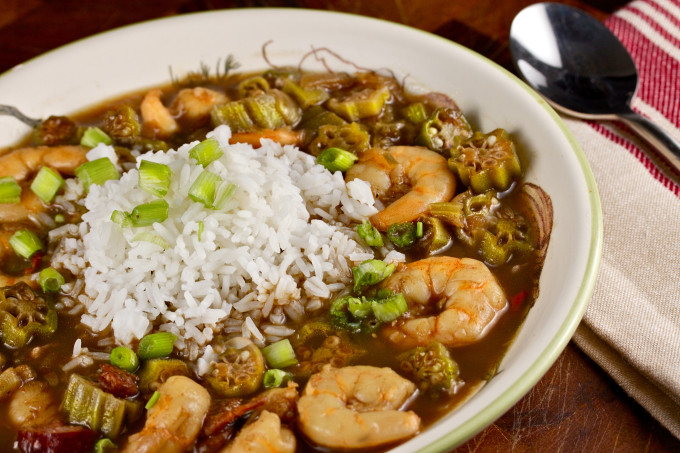
Shrimp and Okra Gumbo blends the best of Cajun cooking and Creole cooking in one delicious bowl. (All photos credit: George Graham)
So what is the difference between Cajun cooking and Creole cooking? For a Louisiana food writer covering Cajun and Creole cooking, that’s akin to asking, “what’s in a gumbo?” There is no clear answer, and that is the beauty of the culture and cuisine. At the risk of becoming embroiled in culinary controversy, let me shed some light on this long and sometimes heated debate.
The difference between the two is most easily explained by looking at the two cultures and their geography. Europeans of wealth and stature settled in the city of New Orleans and brought with them a palate for more gentrified cuisine reminiscent of their French, Spanish or English roots. Over time, servants and cooks of African descent learned these sophisticated recipes and techniques and blended them with their spicy, herb-infused cooking. Before long, tastes mingled into a soulful mix that became the defining taste of Creole. Cooking with tomatoes, cream, butter, cheeses and other more refined ingredients led to the rich cuisine for which New Orleans has become famous. French sauce techniques helped define dishes like shrimp remoulade, trout meunière, oysters Bienville, crabmeat ravigote and so many other great Creole dishes. And those classic European dishes were joined by down home Creole foods like gumbo z’herbes, smoky red beans and rice, dishes spiked with okra, as well as a tomato-infused version of jambalaya.
Meanwhile, in the marshes of southwest Louisiana a different sort of culinary evolution was taking place. In 1755, the expulsion of the French Acadians from Nova Scotia by the British resulted in the migration of thousands of families to the wetlands of southern Louisiana. All along the Gulf coast and northward into the prairie region of Acadiana, settlers put down roots. These were not people of wealth, but simple farming families. To survive, they trapped, fished and hunted for food, and applied their basic rural French culinary skills to simple Cajun recipes that fit their palate. Settlers along the coastal parishes made their livelihood by shrimping, crabbing, and harvesting oysters; further inland, farming the flatlands with sugarcane and rice as predominant crops led to Cajun recipes using all of these indigenous ingredients. The Atchafalaya Basin was a wild source for crawfish, and eventually the rice fields were flooded after the harvest for farming crawfish in a controlled aquaculture environment. Over time, the Germans settled into the region north of Lafayette and brought with them sausage-making and smokehouse skills that blended beautifully into the gumbo of flavors we now know as Cajun cooking.
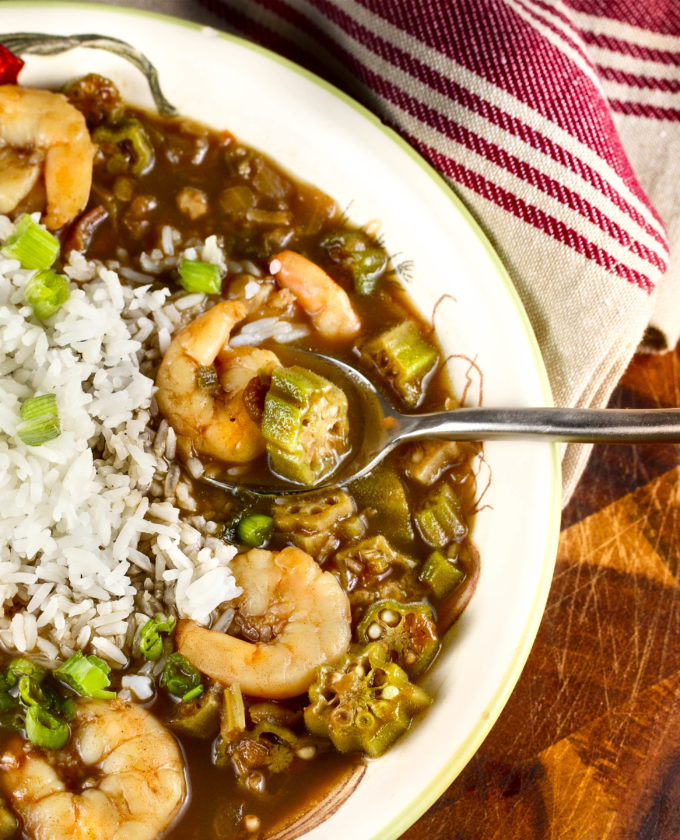
Shrimp and Okra Gumbo is a recipe that links the cultures of Louisiana.
Family plays an important part in Cajun foodways. Even today, celebrations erupt whenever families come together to cook a whole hog. The boucherie and the cochon de lait are French traditions that are important to the Cajun way of life. Even crawfish boils are family celebrations that bring people together over food. Food is a key ingredient of the joie de vivre of living in South Louisiana.
I’ve heard Cajun food described as a basic and unrefined method of rustic, rural, farm cooking. I disagree. To me, that description shortchanges the talent and taste of the culinary art of the French Acadians. I believe the evolution of this distinctly original cuisine is based on artisan techniques handed down for generations and preserved as a cultural treasure. Pride and passion for Cajun cooking are as much defining elements of the people as the music, dance and language. Deep, dark gumbos, spicy tasso, rich crawfish étouffée and black-iron pot rice and gravy are original Cajun recipes steeped in historical reverence for a culture that endures.
But, the explanation doesn’t end there.
I contend that over time Cajun and Creole cuisines have converged into a unique, cross-cultural cuisine that is represented throughout Louisiana. The holy trinity of spices–onion, bell pepper, and celery–is the divine starting point of both cuisines. Okra appears often in gumbos on both sides of the Atchafalaya Basin, and a bowl of creamy red beans with smoked andouille is a link that deliciously bridges the two cultures. The beauty of eating in Louisiana is the blending of flavors into unexpected and surprisingly unique dishes.
Let the debate end. What’s the true Louisiana cuisine? Who cares? The blurring of the lines of distinction of these two cultures has resulted in a truly original, one-of-a-kind cuisine. To celebrate and illustrate this union, I offer up a steaming hot bowl of shrimp and okra gumbo.
One bite and you will clearly understand.
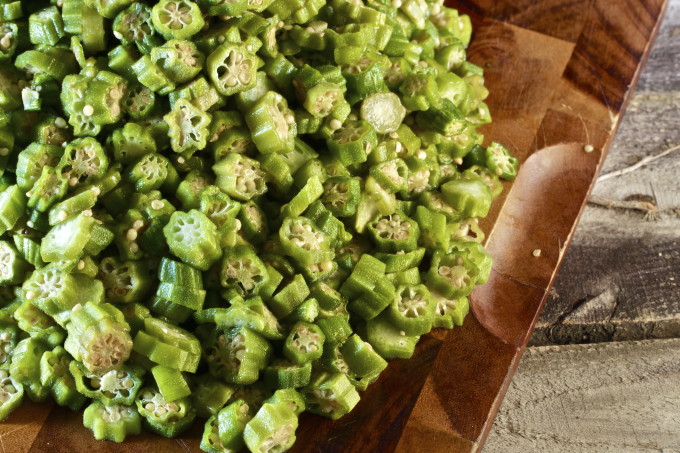
Freshly cut okra adds a Creole touch to this Cajun recipe for Shrimp and Okra Gumbo.
Shrimp and Okra GumboPrep timeCook timeTotal timeRecipe by: George Graham - AcadianaTable.comServes: 6 to 8Ingredients- ¼ cup canola oil
- 2 cups diced yellow onions
- 2 cups diced green bell pepper
- 2 cups diced celery
- 2 tablespoons minced garlic
- ½ cup chopped flat-leaf parsley
- 1 cup chopped tasso or smoked ham
- 2 tablespoons tomato paste
- 12 cups shrimp stock or seafood stock, plus water if needed
- 1 cup dried shrimp
- 2 cups sliced okra
- 1 ½ cups dark roux, such as Rox's Roux
- 1 tablespoon cayenne pepper
- Kosher salt and freshly ground black pepper
- 3 pounds fresh large Louisiana shrimp
- Dash of hot sauce
- 8 cups cooked Louisiana white rice, for serving, such as Supreme
- 1 cup diced green onion tops
- Filé powder
Instructions- In a large cast-iron pot over medium heat, add ¼ cup of canola oil. Once sizzling hot, add the onions, bell peppers, and celery. Sauté until the onions turn translucent. Add the garlic, parsley, and tasso, and sauté until combined. Add the tomato paste and stir to combine.
- Add the shrimp stock along with the dried shrimp. Add the sliced okra. Bring to a boil and add the roux. Lower the heat to a simmer and season with cayenne pepper. Cover the pot and let cook for 1 hour.
- After 1 hour, lift the lid and skim the surface of any excess oil. Taste the gumbo. If you prefer your gumbo thinner, add more stock or water. Add salt and pepper to taste. Add the shrimp, cover the pot and simmer for 20 minutes more. Turn off the heat.
- Uncover the pot and skim the surface of any excess oil. Sample the finished gumbo and season with hot sauce to taste.
- Ladle the gumbo into large bowls over a mound of rice and garnish with diced green onion tops. Have filé powder and hot sauce on the table for adding. Serve with hot French bread.
NotesYou can buy Rox's Roux online or you can make your own roux by reading my wife Rox's story here. I prefer using shrimp or seafood stock to build flavor in this gumbo. For even added flavor, buy a small bag of dried shrimp and add to the stock. In this gumbo, the rich Creole flavors come from adding tomato paste and fresh okra – both of which are important in tying the cultures together. Along with roux, okra is a natural thickener in this gumbo. Some folks like to saute their cut okra to eliminate mucilage (slime), but with a long cooking time, it should be minimal.3.5.3217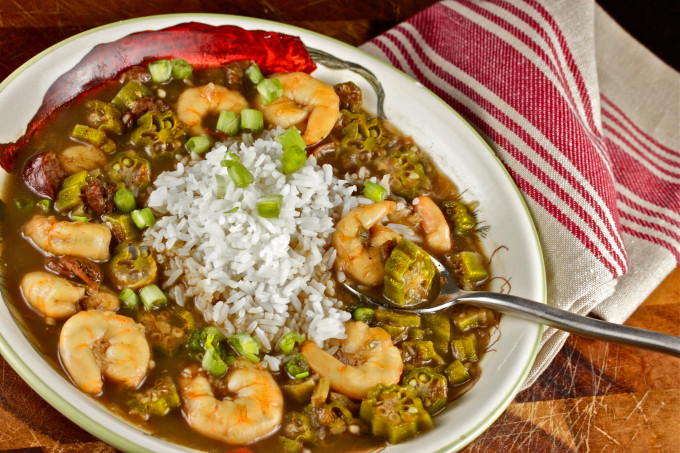
Blending a deep dark Cajun roux with Creole okra is the base for introducing fresh Gulf shrimp in this Shrimp and Okra Gumbo – a classic South Louisiana dish.
YOUR SEAT AT THE TABLE: If you like this Cajun cooking story and Cajun recipe then accept my personal invitation to subscribe by entering your email at the bottom or top right of this page. It’s quick and painless. You will receive an email alert and be the first to see when new Cajun cooking stories and Cajun recipes are added.
Thanks, George.The post Shrimp and Okra Gumbo appeared first on Acadiana Table.
- Soupe à l’oignon Gratinée – The French Louisiana Version
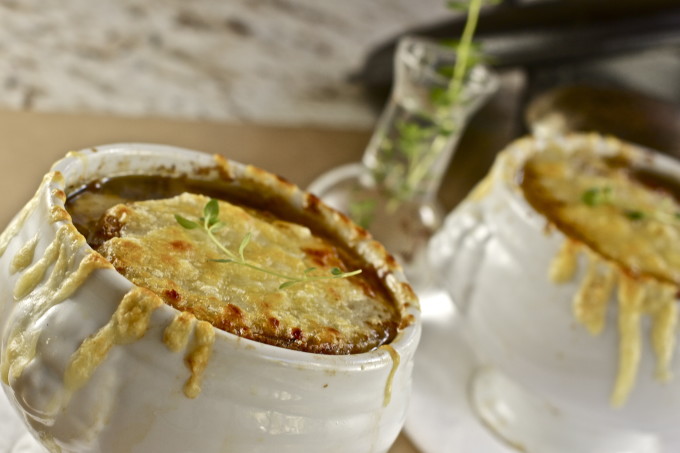
The perfect onion soup in its melted, bubbly glory. (All photos credit: George Graham)
According to the French there are two ways to make classic onion soup – the right way and the wrong way. And even though the French are accustomed to being a bit arrogant when it comes to their cuisine, I must agree. Here’s why.
Like many, for years I made my onion soup with the usual mistakes. Onions simmered for an hour or so in a store-bought chicken broth topped with a toasted slice of French bread and a topping of melted mozzarella. Ouch! Now, don’t get me wrong, back in those days I was quite pleased with my dish, and it was tasty enough that my friends were most complimentary. Well, if it’s true that ignorance is bliss, I was in a state of euphoric stupidity.
Flash forward a bunch of years and a trip to New York that opened my eyes. Not France, but New York was where I had my first taste of an exquisitely prepared French onion soup. I’ve eaten onion soup in France since, but I’ve yet to have a version that tops that one. It was a simple chef-owned French bistro in Soho that focused on the classics, and one taste of his rich, beefy, oniony broth was a mind-expanding experience that set me on the path to discovery.
After dinner and lingering for a while over a glass of Burgundy and a wooden board of cheese, the chef finally appeared from the kitchen. He was a crusty, well-worn Frenchman. He sat sipping a glass of vin rouge and shared the recipe for his classic dish. With a heavy Parisian accent, he disclosed his secrets to me. I took notes.
Beef bones, deeply caramelized onions, a Gruyere gratin and a splash of dry sherry, oh, and chicken feet. Uh, what?
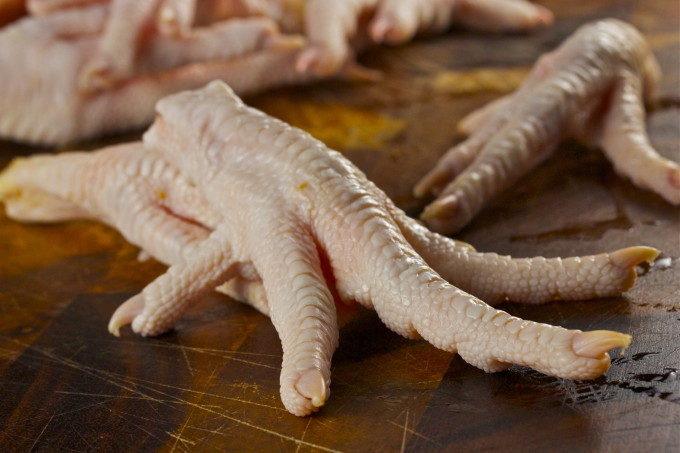
Chicken feet add body and flavor.
Yes, it seems that cooking with chicken feet is classic French – Asian and Latin, too. Traditionally, the classic onion soup is made from a hearty beef stock. And while it’s always about the flavor, he told me he uses specifically chicken feet for the gelatinous thickening it gives his stock. The secret to the rich, round mouth-feel of his beef stock is, of all things, chicken feet. Well, that is essentially all he told me before he finished off his wine and quickly disappeared back into the kitchen. But, that was enough for me to understand the required complexity of a dish that otherwise appears simple. Oh, and one more thing he told me, you’ll spend a couple of days making it.
Okay, please stay with me. I’m not talking about two whole days stolen from your precious life to make a bowl of soup. It just means that ingredients need to come together slowly and with proper time to meld together into perfection. Unattended stovetop cooking is a technique that separates restaurant chefs from home cooks. Long, slow, wine-infused braises, flavor-filled stockpots simmering on a low fire, and marrow-filled bones roasting for hours in a hot oven – these are the French techniques that elevate dishes of all kinds.
Rural Cajun and Creole cooks have known these techniques for generations. And with that in mind, I set out to link classic French with classic Cajun in an interpretation of this dish that could very well become one of your favorites as well. I admit it wasn’t easy. I stumbled through several versions only to find my way back to a more basic version reminiscent of the one I discovered in that little Soho bistro, but with a few Louisiana enhancements.
Patience is the basic ingredient for making this dish. Slip into your culinary rhythm and relax. The broth – dark, rich with beefy body – is the prime reason most amateurs, like me, take so long to discover how good this dish can be. It is time intensive and takes forethought and patience to reach that ultimate flavor that wraps around and infuses the onions.
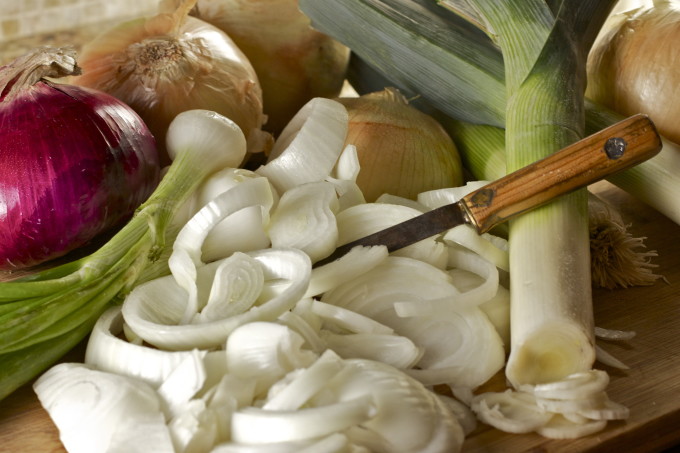
I use a variety of onions.
Oh, the onions. You’ll need to sweat them out, coaxing the sugars to release in a slow, patient dance over a low flame, stirring intermittently. The process can take an hour, sometimes longer. It’s a therapeutic kind of cooking, where you’ve got to pay attention, but not too much. The onions will tell you when they’re ready—when they’ve taken on that deep, dark, caramelized hue, sweet but slightly bitter, with a layer of complexity that feels almost like it was there all along, just waiting to come forward.
Now, let’s talk about the bread. It can’t be any bread; it must be a rustic, crusty French baguette that’s become the foundation of nearly every French dish worth its salt. It’s the kind of bread that, when toasted, holds its own against the weight of that molten cheese. The cheese is just as essential. Gruyère, or Comté, melted and golden, bubbling away like a dream. It blankets the soup, creating that divine contrast of crisp, caramelized edges and gooey, creamy depths beneath.
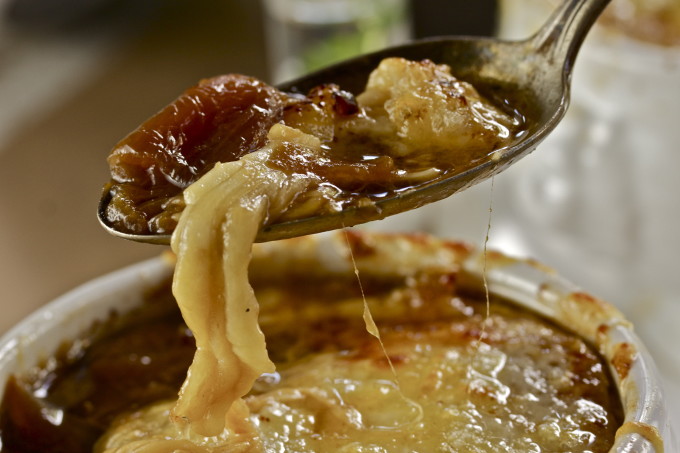
Velvety, luscious and dark with rich flavor — the perfect French onion soup.
French onion soup is more than just a meal; it’s a piece of culture that asks for patience, reverence, and a little time. And at the end of it, you’ve got a bowl of something that tastes like everything good in the world—simple, soulful, and timeless. There’s no rush, no pretense, just the honest, satisfying embrace of one of France’s most enduring classics.
Eat it slow. It’s worth it.
Louisiana French Onion SoupPrep timeCook timeTotal timeListen up! Making this beef stock from scratch is the key to this recipe. While you are at it, make enough to freeze and use for so many other gravy-laced Cajun and Creole dishes.Recipe by: George Graham - AcadianaTable.comServes: 8IngredientsBeef Stock- 5 pounds beef bones
- 2 large yellow onions, quartered
- 4 celery stalks, broken into large pieces
- 4 whole carrots, chopped into large chunks
- 2 tablespoons tomato paste
- 2 tablespoons Creole mustard or coarse-grained mustard
- 1 cup red wine
- 4 quarts water
- 1 pound chicken feet
- 6 black peppercorns
- 2 bay leaves
Onions and Soup- ½ cup bacon fat
- 10 large yellow onions
- 5 medium sweet onions, such as Vidalia
- 2 purple onions
- 3 stalks of leeks, green stems removed
- 6 large spring onions, green stems removed
- 1 tablespoon sugarcane molasses
- 1 tablespoon all-purpose flour
- ½ cup dry sherry
- Kosher salt and freshly ground black pepper
- Bunch of fresh thyme sprigs tied in a bundle
- Slices of French baguette, toasted
- 3 cups shredded Gruyere cheese or Comté cheese
- Several sprigs of fresh thyme, for garnish
InstructionsBeef Stock- Preheat the oven to 400ºF.
- Rinse the beef bones in cold water until all of the blood is removed. Assemble the bones on a large sheet pan and place in the oven. Roast for 1 hour and add the tomato paste and Creole mustard by brushing on the bones. Add the onions, celery, and carrots and continue roasting until browned, about 30 minutes. Once completely browned and caramelized remove from the oven and let cool.
- In a large stockpot over medium heat, add all the meats and vegetables from the pan. Pour off all the grease from the roasting pan. Turn a high burner under the pan and add the wine. With a spatula scrape up the bits and piece as you deglaze the pan and reduce the wine by at least half. Add all the contents to the stockpot. Add the chicken feet, peppercorns and bay leaf. Cover with water. Bring the pot to a boil and then lower the heat to simmer. Cook for 5 hours skimming the surface to remove residual fat and scum every hour.
- Once done, strain the liquids in a fine strainer removing the bones and chicken feet, and place in a covered container to cool. Refrigerate overnight. The next day, skim the fat from the top of the liquid. The beef stock can be used immediately or frozen for future use.
Onions and Soup- Peel all of the yellow, sweet, and purple onions and remove the stem parts of the leeks and spring onions. Slice the yellow onions ¼-inch thick so that once cooked down they will hold their shape. Slice the rest of the onions thin for flavor.
- In a large cast-iron pot over medium heat, add the bacon fat along with all the onions and leeks. Cook slowly and caramelize to eliminate bitterness and achieve sweetness. Try not to stir too much as it will prevent caramelizing. Once the onions begin to brown, add the dark sugarcane molasses – a touch of Cajun country sweetness. Cook for 45 minutes total.
- Cooking these onions requires the same attention as making a dark Cajun roux. Speaking of roux, this is where you add 1 tablespoon of flour.
- Stir the onions and let the flour combine with the bacon grease. You want to achieve a dark caramel color to bring out all the sugars inside the onions, but stop short of burning or they will go from sugary sweet to a burnt bitterness in no time at all. Low, slow, and stirring constantly is the key.
- Remove the onions from the pot to a platter. Turn the heat to medium-high and add the sherry. Stir with a spatula and deglaze the pot scraping up all the browned bits along the bottom. Reduce the sherry by half and turn off the heat.
- Add the onion mixture to a stockpot over medium heat. Add the beef stock until just covering the onion mixture. Add the thyme and let cook for 1 hour.
- After 1 hour, the soup should be combined and thickened. Remove the bundle of thyme. Taste the soup and adjust with salt and pepper.
- In an ovenproof individual bowl, fill with soup and place a toasted baguette on top. Sprinkle a generous handful of cheese and run under a broiler until browned and gratinéed. Garnish with a small sprig of fresh thyme.
NotesAny Latin grocery should have chicken feet. I buy mine at La Morenita market in Lafayette. Buy the finest aged Gruyere (or Comté) cheese you can find. When I make this I make a ton of it and portion and freeze the extra. Warmed up in a slow cooker, it is the perfect make-ahead dish.3.5.3217
YOUR SEAT AT THE TABLE: If you like this story and recipe then accept my personal invitation to subscribe by entering your email at the bottom or top right of this page. It’s quick and painless. You will receive an email alert and be the first to see when new stories and recipes are added. Thanks, George.The post Soupe à l’oignon Gratinée – The French Louisiana Version appeared first on Acadiana Table.
- Backbone Stew
Backbone Stew is more than a meal—it reflects the people who make it. It’s an intimate dish made for family gatherings and Sunday suppers, where the chatter around the table is as important as the food on it. It’s a dish for when things aren’t perfect, but you make do when you take the scraps and lesser cuts to create something extraordinary. This is that dish.
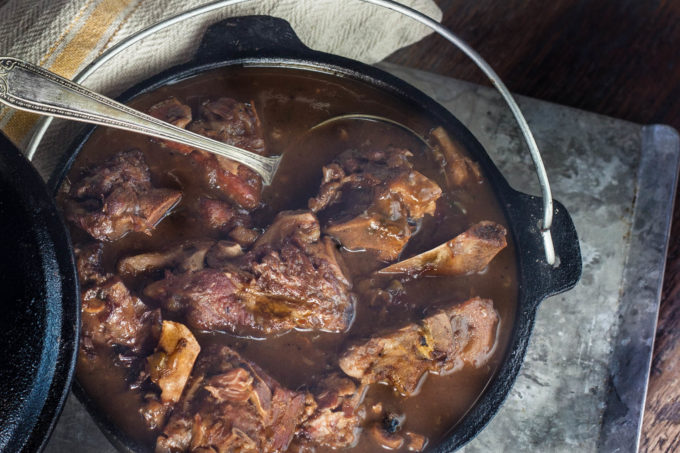
Dark and rich, backbone stew is a classic Cajun recipe. (All photos credit: George Graham)
Admit it, when you think of Cajun recipes, gumbo comes to mind. Maybe jambalaya or even crawfish étouffée are in your limited wheelhouse of South Louisiana cooking. But, that’s only scratching at the topsoil of this lush culinary landscape, and it’s my goal to dig deep and get to the roots of Cajun cooking. Plain and simple, backbone stew made the traditional French Acadian way is an induction into the inner circle of rural Cajun cooking.
You won’t see this Cajun recipe on mainstream menus, and aside from an occasional steam table lunchroom, this dish is relegated to home stovetops and backyard propane cooks. At every boucherie, there’s a backbone stew pot in the background simmering away with what will become the most sought-after prize of the day–a bowl of pork cloaked in rich dark gravy.
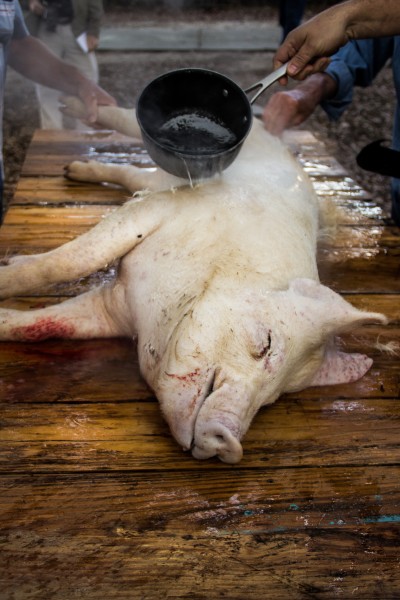
Washing down the hog with scalding water.
Such was the case some years ago during a trek to Eunice, Louisiana, for an early morning boucherie and a bowlful of backbone stew. Pulling up to the fairgrounds on the outskirts of the small St. Landry Parish town, local culinary icon Lance Pitre led me across the field to a cluster of spreading oaks and a crew of two dozen men and women already hard at work. The 160-pound hog was spread out on a large wooden table and scalding hot water was poured over to loosen the skin so the hair could easily be scraped away.
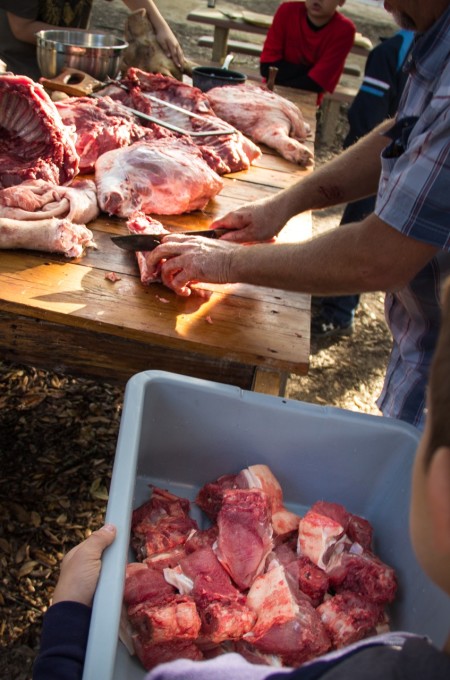
Cutting down the hog for Backbone Stew.
Torches, butcher knives, and saws were busy burning, slicing, and dissecting through the hair, skin, and meat of the pig. Chopping boards spread out across long tables, and folks were busy tending to a dozen or so cast-iron and Magnalite pots. Smokers, meat grinders, and sausage stuffers were prepped and ready to receive their cuts, and charcoal grills were fired up with embers aglow. These are artisans of French Acadian heritage that clearly know their task at hand, and each is an expert in their specialty Cajun recipe.
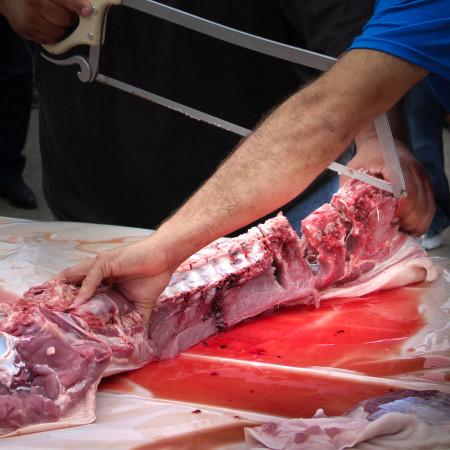
Sawing sections of backbone for the stew pot.
The hog’s head was severed and moved off for head cheese-making; the pig’s feet were cut above the shank and blowtorched to remove any remaining hair; liver for boudin; stomach for a Cajun recipe called ponce; organ meats for fraisseurs; ribs for the grill; and the backbone–the prize cut of all–was reserved for the stew pot. A propane burner blasted away as pork stock infused with dark roux boiled gently in an enormous black iron caldron. The Cajun trinity of chopped vegetables–onions, celery, and bell pepper–soon joined the bony chunks of meat in the backbone stew pot. A heavy dose of cayenne and garlic spiced the brew, and a low and slow simmer produced the magic.
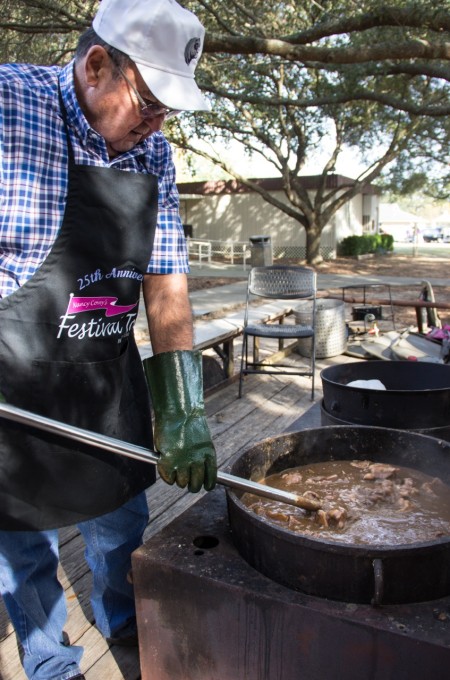
Stirring the pot of Backbone Stew at the Eunice boucherie.
And magical it is. Backbone Stew is the Cajun recipe that, during an episode of Travel Channel’s No Reservations, left Anthony Bourdain momentarily speechless and prompted him to say of his first South Louisiana boucherie, “With all the smells coming from six different directions, smoking and simmering and sizzling … I’m absolutely blown away by the depths of flavor and deliciousness that I’ve rarely encountered anywhere.”
And it strikes me the same; Backbone Stew is the underbelly of Cajun black pot cooking. A complex, darkly divine stew of pork backbone floating in a bowl of roux-infused and pig’s feet-thickened gravy, this is a dish so regally rich, so potently porky, so decadently deep in flavor that you might never come up for air.
Now, don’t be intimidated: This Cajun recipe for Backbone Stew can easily be made in your home kitchen no matter where you live. It might take a search for some out-of-the-norm ingredients (pork backbone and feet), but truth be told, much of Cajun cooking uses familiar ingredients, many of which are easily sourced. But the fun is in adventuring past your culinary comfort zone, and if you sometimes feel uncomfortable, then I have succeeded. And if you awaken your taste buds to new flavors you never knew existed, then you have succeeded. Backbone Stew is a dish made for those who aren’t afraid to taste something with authentic, unapologetic flavor—a flavor that demands to be remembered. And that’s what this true Cajun version delivers: flavor with backbone.
Backbone StewPrep timeCook timeTotal timeThis is thick and hearty, stick-to-the-ribs fare utilizing an inexpensive and underutilized cut of meat.Recipe by: George Graham - AcadianaTable.comServes: 4 to 6Ingredients- 8 strips smoked bacon, chopped
- 2 cups diced yellow onion
- 2 cups diced celery
- 2 cups chopped green bell pepper
- 1 cup chopped flat-leaf parsley
- 1 tablespoon minced garlic
- 8 cups pork (preferably) or chicken stock, plus more if needed
- 1 cup dark roux, plus more if needed (see the recipe for Dark Cajun Roux here)
- 4 pounds pork backbone with meat attached, cut into 4-inch chunks
- 2 tablespoons Acadiana Table Cajun Seasoning Blend, see recipe here
- 2 pig’s feet
- Kosher salt and freshly ground black pepper
- Dash of hot sauce
- 6 cups cooked long-grain white rice, such as Supreme
- 2 cups diced green onion tops
Instructions- In a large cast-iron pot with heavy lid over medium-high heat, add the bacon and cook until crispy. Remove the bacon for later use. Remove all but 2 tablespoons of the remaining bacon grease.
- In the same pot over medium-high heat, add the onion, celery, and bell pepper to the remaining bacon grease. Cook until the vegetables are browned, about 8 minutes, and add the parsley and garlic. Add the stock and roux, and bring to a boil. Lower the heat to a simmer.
- Sprinkle the pork backbone pieces with Cajun seasoning, and add to the pot along with the pig's feet and cooked bacon pieces. Cover and cook on simmer for 1 hour.
- Check to see that the stew is thickening and if needed, add more roux. If too thick, add a bit more stock. Season to taste with salt and pepper. Cover and cook for another 1½ hours.
- Uncover and check to see that the meat from the backbone is fork tender and turn off the heat. Taste the gravy and add hot sauce to taste. (The stew should be spicy, but not enough to disguise the pork flavor.)
- Remove the pig’s feet from the pot and pick the meat from the bone, discarding the skin, bones, and cartilage. Add the picked meat back to the pot.
- Serve a couple of the backbone pieces over white rice in a bowl with plenty of gravy. Garnish with a sprinkle of green onion tops and serve with hot French bread.
NotesHave your butcher reserve the backbone that is cut away from the pork loin during butchering. Pork neck bones can also be used. I find backbone at Kirk Martin's Slaughter House in Carencro north of Lafayette and Poche's Market near Breaux Bridge. I source pork neck bones at Rouses in Lafayette. Be sure to rinse all the pork pieces removing any excess blood. I like using a flavored (pork, preferably) stock for this, but many old-school Cajun cooks will use water. You might think the pig’s feet are optional, but I urge you to add them. The velvet texture and natural thickening of the gravy will astound you. Most any good butcher can stock you up with cleaned pig’s feet or find an Asian grocery. Don't want to make your own roux from scratch; buy Rox's Roux on our Shop site.3.5.3217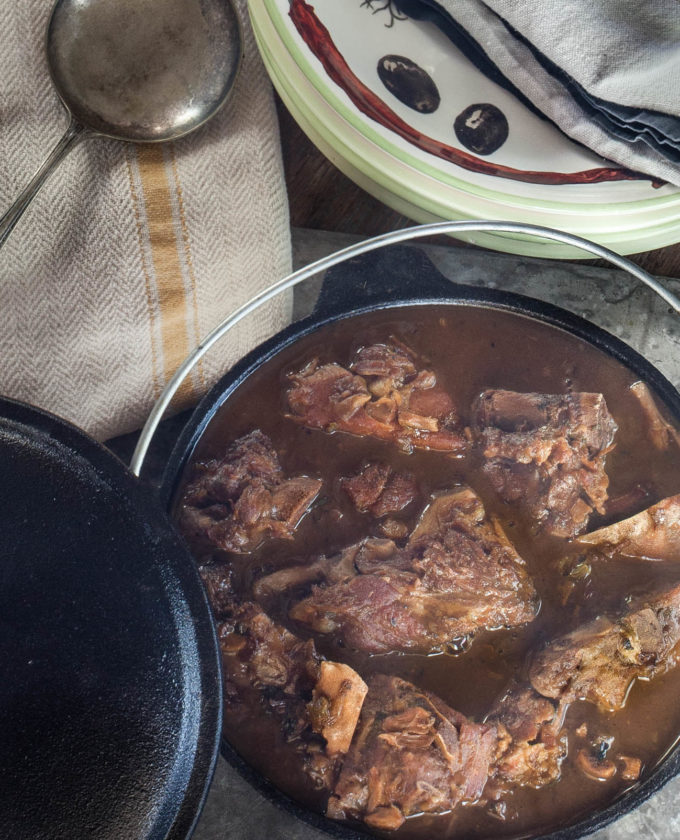
This one-pot Backbone Stew is seen at most every Cajun boucherie.
YOUR SEAT AT THE TABLE: If you like this Cajun cooking story and Cajun recipe then accept my personal invitation to subscribe by entering your email at the bottom or top right of this page. It’s quick and painless. You will receive an email alert and be the first to see when new Cajun cooking stories and Cajun recipes are added. Thanks, George.
The post Backbone Stew appeared first on Acadiana Table.
- Fried Whole Catfish
Fried crispy golden brown, the taste and texture of eating catfish close to the bone is a rare treat these days. But with this recipe, I’m out to bring back an almost forgotten dish.
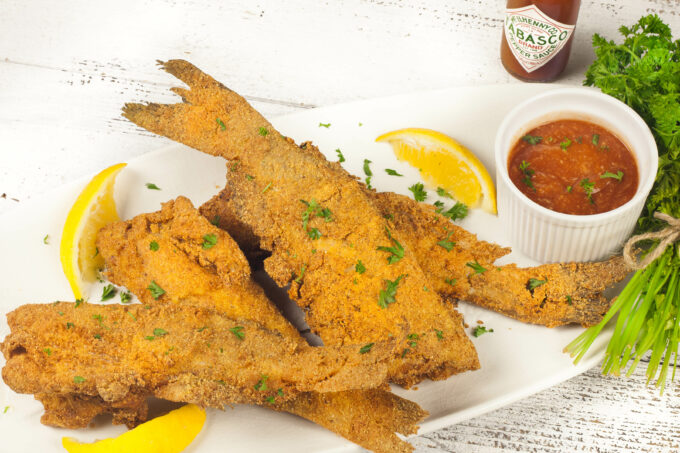
Fried golden brown, this bone-in catfish is a treat. (All photos credit: George Graham)
There was a time in my youth that dining out for dinner usually meant a road trip. Small-town life in the 50s meant that restaurant options were limited, and my father’s café was one of the better options in town. So, for a dining adventure, we usually drove to Covington, Louisiana, or even further to New Orleans. But every once in a while, my father would fire up the Buick Roadmaster, and we would head out of state.
I grew up in Washington Parish along the Mississippi state line, and one of my dad’s favorite spots was Mack’s Fish Camp, a restaurant an hour away from Bogalusa in Hattiesburg, Mississippi. It was a treat to explore unfamiliar territory, and what lay ahead at this roadhouse restaurant was worth the drive.
Mack’s was famous for one thing—whole fried catfish. Back then, along with hushpuppies, coleslaw, and sliced white bread, whole fried catfish was all they served. But what they did with catfish was nothing short of magical. I still remember watching wide-eyed as the waitress set down a huge platter of steaming hot fried catfish in the middle of the table.
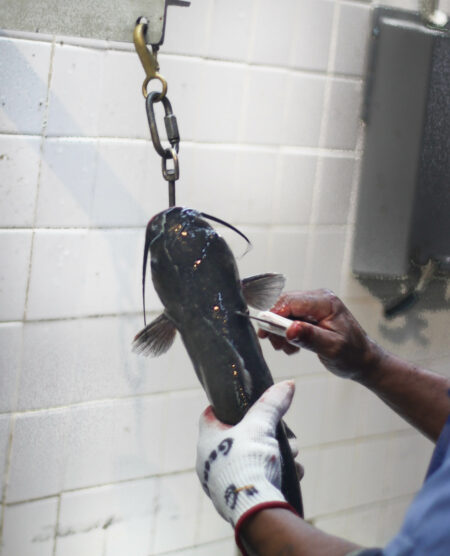
Skinning a wild-caught catfish takes talent.
In my recipe, I’m using wild-caught catfish, a cleaner tasting fish. In the murky waters of the Atchafalaya Basin and along the winding bayous of Louisiana, wild-caught catfish has long been more than just a meal. It is a cornerstone of the food culture of Acadiana, a symbol of resilience, and a testament to the waterways that have sustained generations of Cajun and Creole families.
The significance of catfish to Cajun cuisine dates back to the 18th century, when French settlers, adapting to the bountiful waterways of the Gulf Coast, began to fish the region’s rivers, marshes, and lakes. The catfish, a bottom-dwelling, hardy fish known for its rich, slightly sweet flesh, became a staple in the Cajun diet—its abundance in the wild made it a reliable food source that could be prepared in countless ways.
Not only does the fish carry the flavors of the bayou—earthy, briny, and distinctly untamed—but it also mirrors the spirit of the people who depend on the land and water for their sustenance. These fish are caught using traditional methods like trotlines, hoop nets, or hook-and-line fishing, often by families who’ve fished for generations, passing down their techniques, recipes, and reverence for the fish itself.
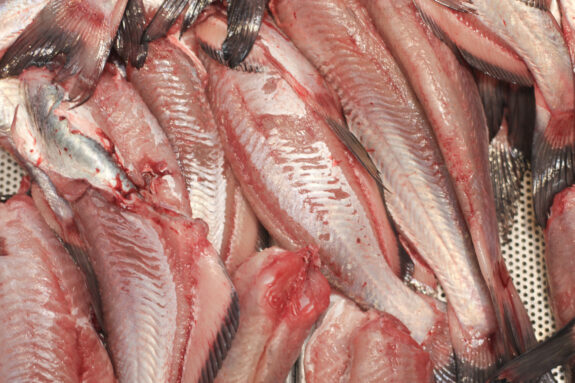
Cleaned whole catfish on the bone.
Of course, fried catfish is the most iconic preparation in Cajun cuisine. This dish, in its simplicity, embodies the essence of the Cajun way of life: direct, bold, and wholly satisfying. I like the smaller size that cooks evenly and quickly in a few short minutes. And the secret to my batter is the addition of pickle juice for tartness and Creole mustard for spice. The dry ingredients are traditional, and if you have a favorite packaged fish fry, then use that.
When I say whole-fried catfish, I mean you’re getting the entire fish—head, tail, and all—tossed in a cornmeal-and-spice mix, dunked into hot oil, and pulled out just as the outside crisps up golden brown. There’s something a little primal about it. Your hands get messy, your fingers stained with grease and seasoning, but that’s part of the experience. It’s a tactile thing—tearing off a chunk of fish, trying to avoid the sharp prickle of bones, picking at the flesh that comes off with ease, savoring the combination of crunchy batter and soft, flaky meat.
As kids, we had to learn how to eat fish on the bone, and it only took one pin bone stuck in your throat to understand the importance of the slice of white bread on the table. Those are great memories, and although there are still plenty of catfish houses throughout the South, fried filleted catfish is usually the restaurant option.
Mack’s is still in operation today, so give it a try when you’re near Hattiesburg. And try my recipe using wild-caught catfish and find out how good eating whole-fried catfish on the bone can be.
Fried Whole CatfishPrep timeCook timeTotal timeRecipe by: George GrahamServes: 4Ingredients- 1 cup whole milk
- 2 large eggs
- ¼ cup pickle juice
- 1 tablespoon lemon juice
- 2 tablespoons Creole mustard or whole-grain mustard
- 1 teaspoon Acadiana Table Cajun Seasoning Blend, see recipe here
- 1 teaspoon hot sauce
- 1 cup yellow cornmeal
- ½ cup all-purpose flour
- 1 teaspoon lemon pepper
- ½ teaspoon kosher salt
- 1 gallon peanut oil or vegetable oil
- 4 (8 to 12 ounce) whole wild-caught catfish, cleaned
- 3 tablespoons chopped parsley
- Lemon wedges, for serving
- Cocktail sauce, for serving
Instructions- In a large bowl, add the milk, eggs, pickle juice, lemon juice, mustard, Cajun seasoning, and hot sauce. Whisk until blended.
- In a large bowl, add the cornmeal, flour, lemon pepper, and salt. Stir the dry mixture together.
- In a deep fryer or Dutch oven over medium-high heat, add the oil and bring to a temperature of 350ºF.
- Add the catfish to the liquid mixture and coat on all sides.
- Transfer the catfish to the dry mixture and coat on all sides.
- Place the battered catfish on a tray and chill in the refrigerator for 10 minutes to let the batter set.
- In batches, add the catfish to the hot grease (do not crowd the pot). Let cook on all sides until golden brown and fully cooked, about 5 to 8 minutes . Remove to a wire rack lined with paper towels to drain.
- Serve family-style with a sprinkle of fresh parsley, lemon wedges, and your favorite cocktail sauce on the side.
NotesSearch out whole wild-caught catfish for the highest quality. In the Lafayette area, you can order it from Fresh Water Seafood in Loreauville. And in Baton Rouge, buy it at Tony's Seafood.3.5.3217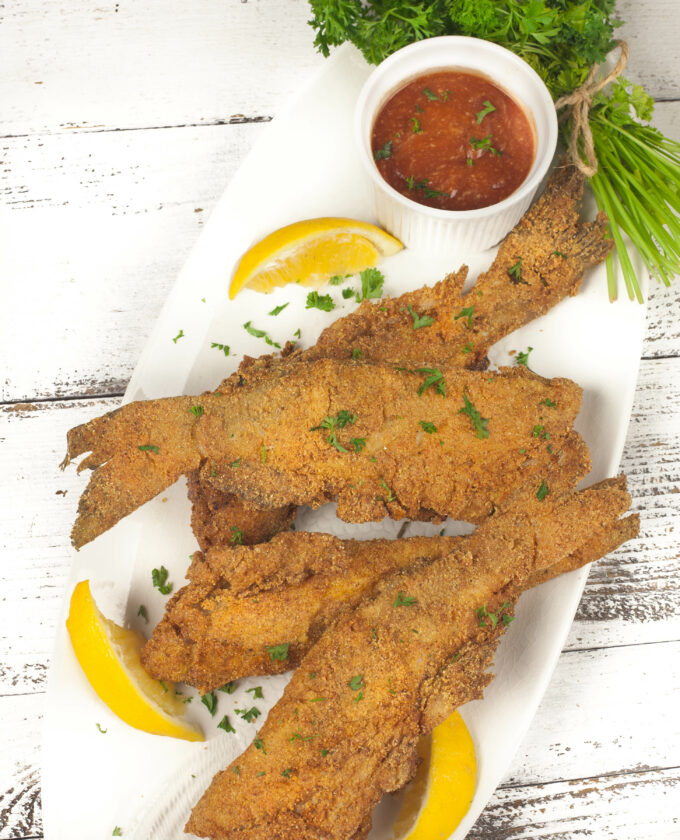
The tastiest catfish ever!
YOUR SEAT AT THE TABLE: If you like this Cajun cooking story and Cajun recipe then accept my personal invitation to subscribe by entering your email at the bottom or top right of this page. It’s quick and painless. You will receive an email alert and be the first to see when new Cajun cooking stories and Cajun recipes are added. Thanks, George.
The post Fried Whole Catfish appeared first on Acadiana Table.
- Chicken and Smoked Sausage Gumbo
It’s Fat Monday, ya’ll! Lundi Gras (French for Fat Monday) ramps up the Mardi Gras holiday with a full schedule of parades, balls, and of course, the Courir de Mardi Gras—the rural Cajun celebration before the beginning of Lent.
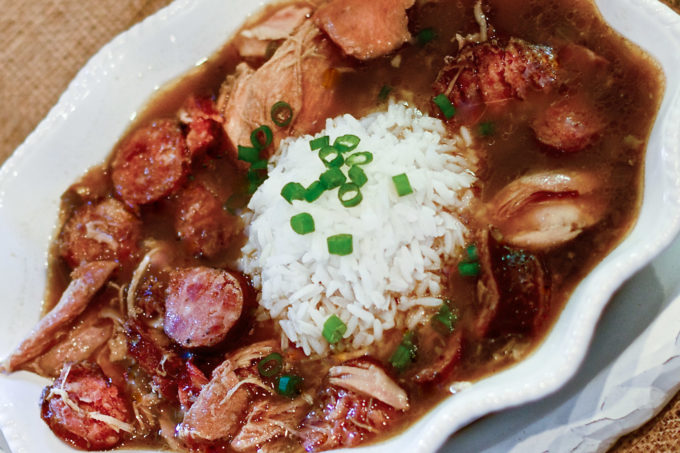
Chicken and smoked sausage gumbo worth begging for. (All photos credit: George Graham)
Break out your capuchon (a cone-shaped ceremonial hat), don a colorful mask, tank up with your favorite beverage—it’s time to start begging. Explanation needed? The Courir is my favorite of all the Mardi Gras customs seen throughout Acadiana.

Colorfully dressed Mardi Gras revelers beg for Cajun recipe ingredients for their celebration gumbo.
Unlike the lavish parades of New Orleans, this celebration takes place in the small communities that dot the region. It is a family event with just as many kids as adults dressing up and riding (sometimes by horseback) from house to house to beg for Cajun recipe ingredients to make a chicken and smoked sausage gumbo celebration.

Gimme something mister!
The custom dates back to medieval France with its origin in the Catholic religion, and the garish garb is said to mock aristocratic society. Here in Cajun country, troops of revelers, led by Le Capitaine, move from house to house “begging” for ingredients to make a Chicken and Smoked Sausage Gumbo. My wife Roxanne recalls that when she was little, she would hide behind her grandmother Mo Mo Eve when the “beggars” rode up to their house every Mardi Gras. And when her grandmother appeared on the front porch with a sack of onions or such, the masked merrymakers would break into music and dance. The highlight is at the end of the ride when a live chicken is thrown into the crowd, and the chase ensues.

Dancing for their dinner!
It all culminates at the communal gumbo when the fiddles bow up, and the squeezebox plays chank-a-chank music for the crowd as the black-iron pots simmer away. This is a colorful Cajun tradition that few get a chance to experience. But my Cajun recipe for Chicken and Smoked Sausage Gumbo is one that everyone can enjoy.

Time for chicken gumbo!
Of all the gumbos, chicken and smoked sausage gumbo defines rural Cajun food culture. Deep, dark roux-based flavor is punched with smoky pork andouille sausage, and it’s spiked with just enough heat to make you grab for another beer and beg for another bowl.
Chicken and Smoked Sausage GumboPrep timeCook timeTotal timeRecipe by: George Graham - AcadianaTable.comServes: 6 to 8Ingredients- 4 tablespoons vegetable oil
- 4 chicken thighs, bone-in and skin-on
- 2 chicken breasts, bone-in and skin-on
- 2 cups diced yellow onions
- 2 cups diced green bell pepper
- 2 cups diced celery
- 2 tablespoons minced garlic
- ½ cup chopped flat-leaf parsley
- 2 cups chopped smoked andouille or pork sausage, sliced into bite-size pieces
- 12 cups chicken stock, plus water if needed
- 2 teaspoons cayenne pepper
- 2 teaspoons Acadiana Table Cajun Seasoning Blend, see recipe here
- 1 cup dark roux, such as Rox’s Roux
- Kosher salt and freshly ground black pepper
- Dash of hot sauce
- 8 cups cooked Louisiana long-grain white rice, such as Supreme, for serving
- 1 cup diced green onion tops
- Filé powder, for serving
Instructions- In a large cast-iron pot over medium-high heat, add the oil. Once sizzling hot, add the chicken pieces skin-side down. Brown the chicken on one side and turn to brown the other side. Remove the chicken to a platter and keep warm.
- To the pot, add the onions, bell peppers, and celery. Sauté until the onions turn translucent, about 5 minutes. Add the garlic and parsley, and sauté until combined. Add the sausage and sauté just until it begins to brown. Add 1 cup of stock to the mixture and scrape the bottom of the skillet to loosen the brown bits of flavor. Add the chicken back to the pot.
- Add enough additional chicken stock to the gumbo pot to cover all the chicken and vegetable mixture. Season with cayenne pepper and Cajun seasoning; stir to combine. Add the roux and stir to combine. Bring the pot to a boil and then reduce the heat to a simmer. Cover the pot and let cook for 1 hour.
- Uncover and remove the chicken pieces. Skim the surface of any excess oil. Taste the gumbo and if you prefer your gumbo thinner, add more stock; if thicker, add more roux. Add salt and pepper to taste. Cover the pot and simmer for 30 minutes longer.
- Uncover the pot and once again skim the surface of any excess oil.
- At this point, you can leave the chicken on the bone or remove the bones and skin from each of the pieces. Just prior to serving, add the chicken back to the pot, cover, and simmer for 20 minutes more.
- Uncover the pot and skim the surface of any excess oil. Sample the finished gumbo and season with more Cajun seasoning and hot sauce to taste.
- Ladle the gumbo into large bowls over a mound of rice and garnish with diced green onion tops. Add a bit of filé powder if you like.
NotesIf you want to make roux from scratch, follow Rox's recipe here, and if you want to use jarred roux, get Rox's Roux here or buy it online at our Shop site. Most Cajun folks serve cold and creamy mustard potato salad with their gumbo. Ice-cold beer and hot French bread are a given.3.5.3217
YOUR SEAT AT THE TABLE: If you like this Cajun cooking story and Cajun recipe then accept my personal invitation to subscribe by entering your email at the bottom or top right of this page. It’s quick and painless. You will receive an email alert and be the first to see when new Cajun cooking stories and Cajun recipes are added. Thanks, George.The post Chicken and Smoked Sausage Gumbo appeared first on Acadiana Table.
- Coq Au Vin – My Tribute to Julia Child
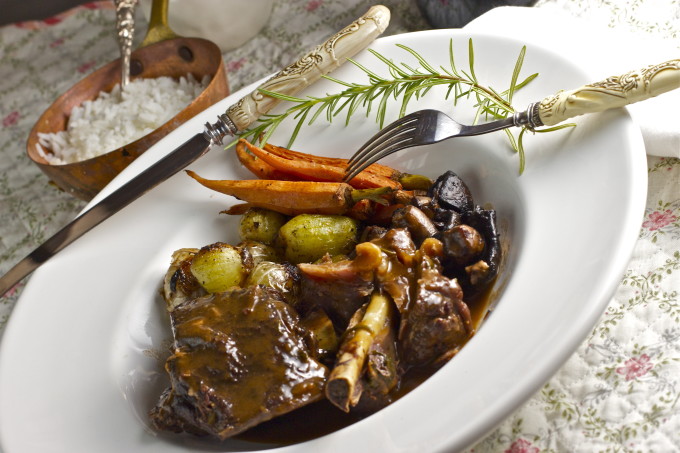
Coq Au Vin — a simple French classic dish. (All photos credit: George Graham)
“I love cooking with wine – sometimes I even put it in the food!”
– Julia ChildOne tough old bird. No, not Julia. Although she certainly was, I have too much respect to talk in those tones when paying homage to the one-woman, gastronomic tour de force that wrote Mastering the Art of French Cooking, and essentially brought classic French recipes into every home in America. No, the bird I’m talking about is a tough old rooster that’s just perfect for a classic Cajun version of Coq Au Vin.
Paying respect to the maven of French cooking in a food blog has already been covered in books and movies, and if you haven’t seen Julie and Julia then get the DVD for a great retrospect of her amazing career. No, I aim to criss-cross the Cajun culture with the definitive Coq Au Vin recipe she introduced to America. And the point is Julia could have saved herself a trip to Paris and just driven down to Acadiana in the 1950s to learn the art of French culinary technique.
As I think about it, what if Julia Child had traveled to South Louisiana instead of Paris, and did for Cajun and Creole cooking what she did for French cooking? She would have still taught America how to make a roux, but the nation would be eating Crawfish Etouffée instead of Lobster Thermidor. On second thought, I’m glad she didn’t–Louisiana crawfish are expensive enough without the entire country consuming them.
Coq au vin is a dish that is romanticized and reduced to mere comfort food for some, but for those who know its history and its roots, it’s a dish that demands respect. And respect, in this case, means using a rooster. It’s not a whim. It’s not some nostalgic nod to tradition. It’s the way the dish was meant to be cooked.
The technique behind Coq Au Vin–slowly braising a tough bird in liquid–is basic to every rural Cajun home cook. The ingredients may differ–less emphasis on wine and mushrooms–but much remains the same. Roosters and tough hens are sought after for their intense rustic flavor and their ability to stand up to a long braise. It’s a bird that has lived a life, not some factory-farmed broiler that’s ready for the pot after just a few weeks. The muscle and sinew of the rooster break down slowly, and its meat becomes soft but still textured, absorbing the wine, garlic, thyme, and onions.
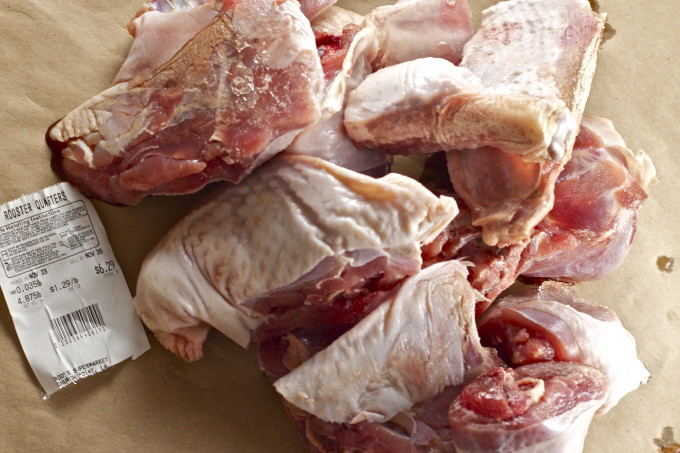
Look for rooster in the rural supermarkets or make friends with a farmer.
I don’t normally run across rooster in the suburban supermarkets I frequent in Lafayette, but when you get out into the small-town rural parts of the region you happen upon all kinds of interesting cuts. I once saw sweetbreads in a Jennings, Louisiana Piggly Wiggly, and smoked pig tails and beef tongue are in every refrigerated case outside the city. But, it was at Rod’s supermarket in Church Point, Louisiana that I found a 5-pound, cut-up rooster, and Julia came to mind.
There are several traditional elements to this dish that define the French version of which I will deviate from in this Louisiana version–thickening method being one key difference. You see, holding true to French tradition, the blood of the rooster would be reserved to add to the sauce as a thickening agent. At the risk of losing my readership, I will instead substitute another classic, and more acceptable, French method–the beurre manié.
Just as this recipe transforms a tough old bird into a classic dish, so too, did America’s embrace of Julia Child turn the unapproachable French art of cooking into an easily accessible part of our culinary lives.
Thank you, Julia.
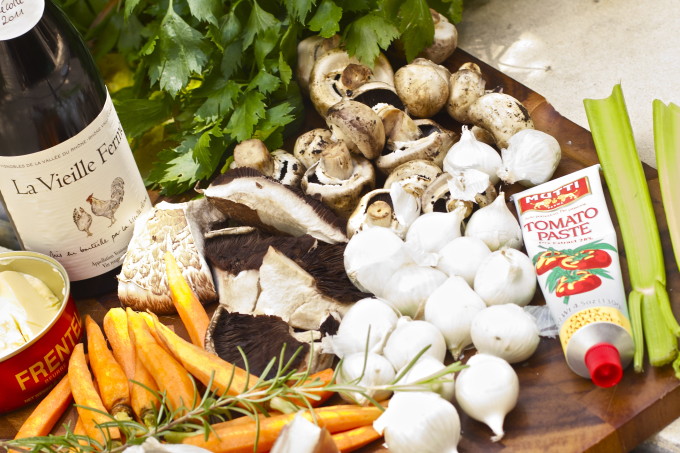
Start with quality ingredients to make the classic Coq Au Vin.
Coq Au VinPrep timeCook timeTotal timeIf you do break with tradition and make this dish with chicken thighs, the cooking time will be drastically reduced, and I take no responsibility for the outcome. I can assure you it will not come close to the flavor or experience of cooking this true French classic. And please, out of respect for Julia, let’s not call it Coq Au Vin.Recipe by: George Graham - AcadianaTable.comServes: 4Ingredients- 1 rooster (4 to 5 pounds), cleaned and butchered into serving pieces
- Kosher salt and freshly ground black pepper
- 1 pound smoked bacon, cut into small pieces
- 12 small boiler onions or pearl onions, stem end removed and peeled
- 5 tablespoons unsalted butter, softened, divided
- 1 pound assorted mushrooms, cut into bite-sized chunks
- ½ cup all-purpose flour
- 1 (750 ml) bottle red wine, such as French Burgundy
- 2 cups dark chicken stock
- 2 tablespoons tomato paste
- 1 yellow onion, halved
- 3 stalks celery, chopped
- 2 tablespoons minced garlic
- 3 bay leaves
- 6 sprigs fresh thyme
- 2 sprigs fresh rosemary
- ¼ cup chopped flat-leaf parsley
- 1 pound baby carrots, whole with stems removed
- 2 tablespoons all-purpose flour
- 4 cups cooked Louisiana long grain white rice, such as Supreme
Instructions- Unwrap the rooster package and discard the neck and giblets. Rinse the pieces in cold water. Pat dry and place on a platter. Sprinkle both sides with salt and let rest at room temperature.
- In a large cast-iron pot over medium heat, add the bacon pieces and sauté slowly until they are lightly browned. Remove the bacon to a side dish lined with paper towel. Save for later use.
- In the same pot with the bacon grease, add the small boiler onions. Sauté until brown, and then move to a platter to keep warm.
- Add 2 tablespoons of butter to the remaining bacon grease and melt. Add the mushrooms to the pot and brown. Move to a platter.
- In a mixing bowl, add the flour. Add the rooster to the flour and coat lightly on all sides. Place the rooster pieces into the pot and brown on all sides. Remove the chicken pieces to a platter.
- Add 2 tablespoons of the remaining breading flour to the remaining oil in the pot and stir to make a light roux. Once the roux has turned a light beige color, add the bottle of red wine along with the chicken stock, tomato paste, onion, celery, garlic, bay leaf, thyme, rosemary, and parsley. Add the rooster and the bacon pieces back to the pot. Cover and lower the heat to simmer and cook for 2 hours, stirring every half hour.
- Once the rooster is done, remove the pieces to a casserole dish and place in a 150ºF oven to keep warm.
- With a colander over a pot, strain the sauce removing all vegetables and herbs as well as the bacon pieces. Place the pot on the stove on medium-high heat to thicken.
- Mix equal amounts (2 tablespoons each) of softened butter and flour to make a beurre manié (a classic French culinary technique) to thicken the sauce. Stir into the sauce until it reaches the desired thickness.
- Into the sauce, add the boiler onions, sautéed mushrooms, and baby carrots. Cook for 20 minutes over medium heat until the largest onion is tender. Taste the sauce and adjust the flavor with salt and pepper. Add 1 tablespoon of butter to the sauce for a finishing touch.
- Add the rooster pieces back to the pot and bring to temperature.
- For serving, place the rooster in the center of a large platter. Arrange the onions to one side and the mushrooms on the other with the carrots in between. Add a few spoonfuls of sauce over the rooster and serve the rest on the side.
- Noodles are the traditional French accompaniment for this dish, but a bowl of white rice is acceptable in French Louisiana. Serve with hot French bread and a quality French butter along with a bottle of your best red wine.
3.5.3217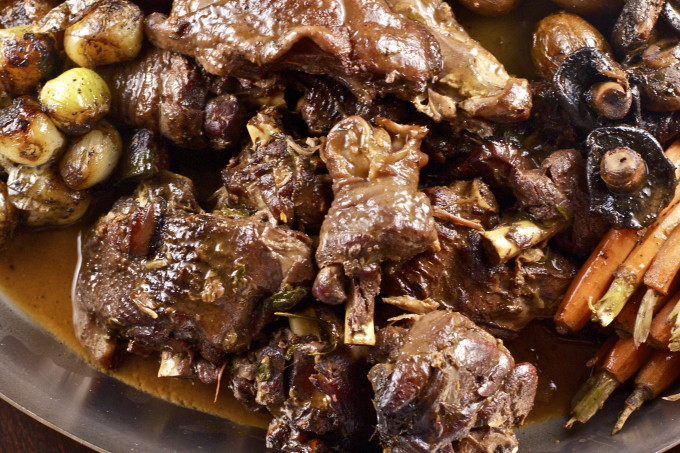
Braised rooster in a rich wine sauce is the focus of this French classic.
YOUR SEAT AT THE TABLE: If you like this story and recipe then accept my personal invitation to subscribe by entering your email at the bottom or top right of this page. It’s quick and painless. You will receive an email alert and be the first to see when new stories and recipes are added. Thanks, George.
The post Coq Au Vin – My Tribute to Julia Child appeared first on Acadiana Table.
- Blueberry Basil Pastry
Fresh blueberries rock my world. And when jammin’ with sweet basil and stuffed inside a crispy pastry, I just can’t get enough. I can assure you this Blueberry Basil Pastry will rock your world, too.

Crispy golden brown, my Blueberry Basil Pastry is oozing with fresh flavors. (All photos credit: George Graham)
You might call these turnovers, tarts, or even a hot pocket, but by any name, they are the perfect breakfast wake-up call. Bursting with fresh fruit flavor and baked up crispy and crumbly, the store-bought puff pastry works magic in this recipe.
While it appears difficult and will most certainly impress your family, I like the ease of this dish and the satisfaction you get from baking it yourself. And an added bonus: You are sure to have leftover jam for topping a basket full of biscuits.
So with this unique fruit and herb combination, it’s time to turn over a new leaf with my easy recipe for Blueberry Basil Pastry.
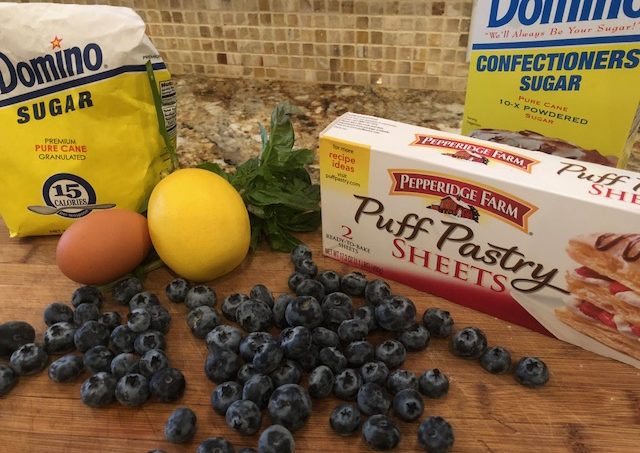
Store-bought puff pastry combines with simple pantry ingredients for dramatic (and simple) results in this Blueberry Basil Pastry.
Blueberry Basil PastryPrep timeCook timeTotal timeRecipe by: George Graham - AcadianaTable.comServes: 4Ingredients- ½ cup chopped fresh basil, stems removed
- Juice from half a lemon, seeds removed
- ½ cup water
- 4 cups fresh blueberries, stems removed
- 1½ cups sugar
- 1 package powdered pectin
- 1 (17-ounce) package frozen Pepperidge Farm Puff Pastry sheets (2 sheets), thawed, but still cold
- 1 beaten egg
- ½ cup powdered sugar
- 2 tablespoons lemon juice
Instructions- In the container of a blender, add the basil, lemon juice, and water. Blend on high until completely pulverized.
- In a pot over medium-high heat, add the blueberries and the basil mixture along with the sugar. Bring to a boil and add the pectin. Stir for 1 minute while boiling, then lower the heat to a simmer. While on the stove, break up about half of the blueberries with a potato masher or immersion blender. Once it begins to thicken (about 1 minute), turn off the heat and let cool. Using a spoon, skim off any foam from the top. Refrigerate until ready to use.
- Preheat your oven to 400ºF.
- Unpackage and roll out the pastry sheets and cut into 5-inch squares. Spoon 2 tablespoons of the jam into the middle of each and fold the pastry from corner to corner in a triangle shape. Brush the edges with egg wash and pinch to seal. Brush the tops with more egg wash and place on a parchment-lined baking sheet. Reduce the oven temperature to 375ºF and bake until puffed up and golden brown, about 15 minutes.
- Meanwhile, in a small mixing bowl, whisk the powdered sugar and lemon juice until it combines into a glaze.
- Remove the pastries from the oven and brush with the glaze. Serve immediately with a hot cup of Louisiana café au lait.
NotesAny leftover jam can be refrigerated for up to a month. If you want larger pastries, just cut your squares larger and buy more puff pastry sheets. If blueberries are hard to find, use strawberries or raspberries, or even an apple filling. These pastries bake quickly so keep a watchful eye out to prevent burning.3.5.3217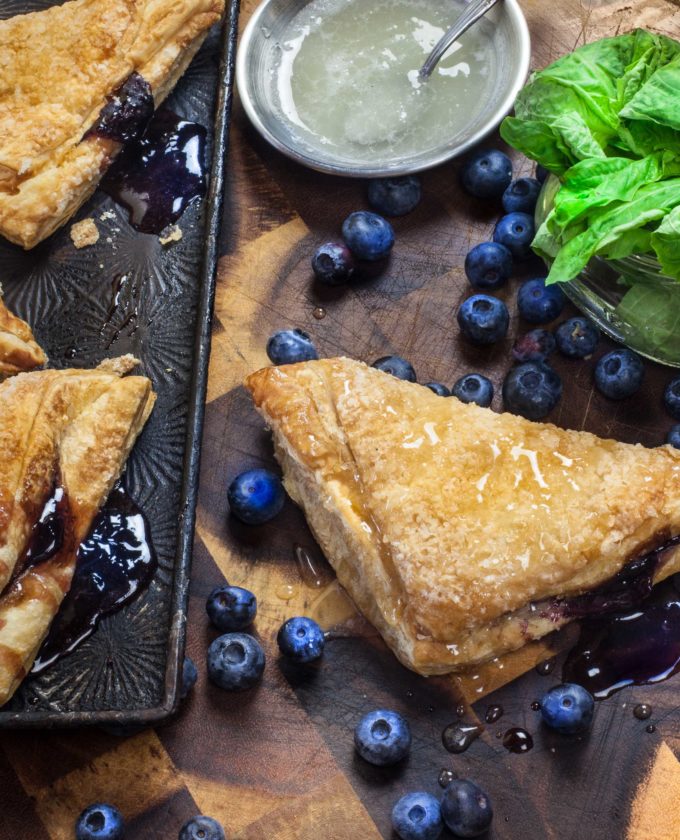
Ah, the sweet life!
YOUR SEAT AT THE TABLE: If you like this Cajun cooking story and Cajun recipe then accept my personal invitation to subscribe by entering your email at the bottom or top right of this page. It’s quick and painless. You will receive an email alert and be the first to see when new Cajun cooking stories and Cajun recipes are added. Thanks, George.
The post Blueberry Basil Pastry appeared first on Acadiana Table.
- Boudin King Cake
Year after year, my Boudin King Cake is the top Mardi Gras recipe on Acadiana Table. And could this Boudin King Cake recipe be easier? Well, actually it could if we did a 1-minute video to demonstrate how simple it is. Take a look and then scroll down for all the details.
There are many great reasons to live in Louisiana, but Mardi Gras has to be near the top of the list. And king cake–the most regal cake of all–makes the carnival season even more special. This sugary confection comes out of hiding about three weeks before Mardi Gras day and is obsessed over by legions of passionate pastry aficionados who devour and debate their way through every king cake. And then it’s gone in a flash–into sweet hibernation.
Boudin King Cake: Cheese-stuffed boudin regally encased in crusty, pepper jelly-glazed bread–the king of all cakes. (All photos credit: George Graham)
But does king cake have to be sweet? Why not a savory and spicy version featuring boudin? After a few rounds of trial and error, I found the perfect balance–tasty and easy–for my Boudin King Cake. There are only six key ingredients in this Cajun recipe: Start with your favorite boudin or make your own; you’ll need a block of pepper jack cheese; pick up a couple packages of Crescent dinner roll sheets (not the rolls), open up a jar of red pepper jelly; chop some green onion tops; and fry up some crispy bacon.
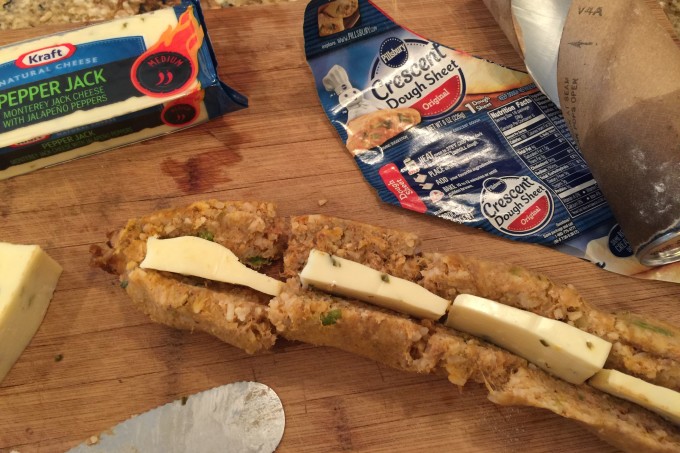
Remove the casing from the boudin, stuff with cheese and wrap in a dough sheet — Boudin King Cake couldn’t be simpler.
Once you gather all your ingredients, the assembly of this Cajun recipe is easy, and this Boudin King Cake bakes up golden brown and spicy delicious in less than an hour.
Crispy bacon-topped crusty bread filled with spicy boudin oozing with pepper jack and glazed with a fiery sweet pepper jelly–this easy Cajun recipe for Boudin King Cake is reason enough for Mardi Gras to last year round.
Boudin King CakePrep timeCook timeTotal timeRecipe by: George Graham - AcadianaTable.comServes: 4 to 6Ingredients- ½ cup red pepper jelly, such as Tabasco
- 1 tablespoon water
- 1 pound boudin links
- 1 (8-ounce) package pepper jack cheese, cut into planks
- 2 (8-ounce) cans Pillsbury Crescent dough sheets or French bread sheets, 1 sheet per can
- 1 large egg, beaten, for brushing
- Kosher salt
- ½ cup crumbled bacon
- ½ cup diced green onion tops
Instructions- Preheat the oven to 350ºF.
- For the glaze, in a saucepan over medium heat, add the red pepper jelly and let cook until it softens and begins to melt, about 2 minutes. Add the water and stir until it thins out. Turn off the heat and keep warm.
- Lay out 2 links of boudin, and with a sharp paring knife, slice down the length of the boudin casing. Peel off the casing and discard. Slice halfway into the boudin the full length of the link. Wedge a plank of cheese into the opening at intervals along the boudin. Push down and close up the boudin around the cheese.
- Open a dough sheet package and unroll the sheet. Place the cylinder of cheese-stuffed boudin on the sheet and roll the dough around. Cut off the excess and pinch the ends closed. Repeat with the second link of boudin.
- On a metal baking tray sprayed with non-stick spray, place the 2 dough-wrapped boudin cylinders and join them together at the ends to form a circle. Brush the top with egg wash and sprinkle with salt.
- Place in the oven and bake for 40 minutes or until golden brown. Remove from the oven.
- With a spoon or brush, drizzle and paint the pepper jelly over the top of the hot pastry. Sprinkle the top with crumbled bacon and diced green onion tops.
- Serve on the baking tray by slicing the boudin king cake into portions and calling your guests while it’s piping hot.
NotesIn Louisiana, freshly made boudin is sold most everywhere (even gas stations), but if you want to make your own, follow my Cajun Boudin recipe here. Boudin links (casing removed) make this easy and are the perfect size for rolling in one sheet of dough. Keep the boudin and the dough cold for ease of handling. The Crescent dough SHEETS (not the rolls) are a relatively new product (at least, for me), and I find them in many (but not all) supermarkets. Use the Pillsbury French bread sheets as a substitute. When opening, the dough sheet should roll out neatly, but if it tears, just pinch it back together with your fingers. Scale up this recipe by matching each link of boudin with a dough sheet (and more cheese, of course). For the inside dough to cook, and the cheese to melt, it is essential to let the bread bake until golden brown. To reheat, place the baking tray back into the oven set on 200ºF until just warmed through. UPDATE: An avid follower of Acadiana Table makes a fresh Italian sausage and mozarella version of this recipe; I'm trying that next time.3.5.3217
Melted cheese and spicy boudin royally redefines the Mardi Gras king cake in this easy Cajun recipe for Boudin King Cake.
YOUR SEAT AT THE TABLE: If you like this Cajun cooking story and Cajun recipe then accept my personal invitation to subscribe by entering your email at the bottom or top right of this page. It’s quick, painless, and FREE. You will receive an email alert and be the first to see when new Cajun cooking stories and Cajun recipes are added. Thanks, George.
The post Boudin King Cake appeared first on Acadiana Table.
- Seafood Bisque
With its creamy depth of seafood flavor accented by white wine and the rich flavor of artichoke hearts, my Seafood Bisque is a rich and decadent Louisiana dish that is as historical as it is delicious.
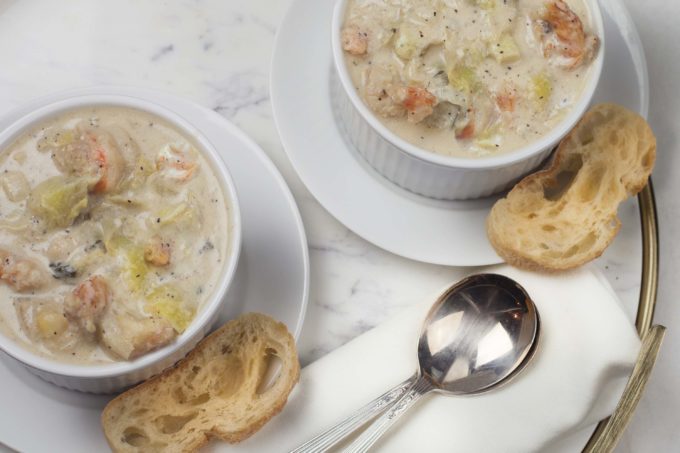
A Creole classic: Seafood Bisque. (All photos credit: George Graham)
This Seafood Bisque is what I like to call “Haute Creole.” It’s a classic, time-honored, New Orleans specialty served in the finest white-tablecloth eateries in the city. I obsess over this dish and order it most anytime I see it.
I suspect the New Orleans Creole cooks of the 1800s were influenced by the European taste for cream, butter, and wine (ingredients seldom seen in Creole culture of the time), and the inclusion of artichoke came from the Sicilian migration of the period. All along the Louisiana coast, a bountiful supply of fresh Gulf shrimp and blue crab was readily available, and the dish was embraced widely by the aristocratic society of the region.
Meanwhile, over in Acadiana, the farm-to-table diet of Cajun families was more attuned to meats (mostly pork and wild game) and the coastal seafood catch, which was cooked simply and without the flair and flavors of the city. Artichokes were non-existent at the time, and it would be years later that Italians began to influence the Southwest Louisiana region. Even to this day, you rarely see this cream-based Seafood Bisque on Acadiana kitchen tables, and only occasionally in restaurants.
For me, this beloved dish is a special treat, and with this simple recipe, you can easily bring my Seafood Bisque to your table, too.
Seafood BisquePrep timeCook timeTotal timeRecipe by: George Graham - AcadianaTable.comServes: 4 to 6Ingredients- ½ stick (4 tablespoons) unsalted butter
- 1 cup finely diced yellow onion
- 1 (14.50-ounce) can artichoke hearts, quartered and packed in water, drained
- 2 teaspoons minced garlic
- 1 tablespoon diced green onion tops
- 1 tablespoon chopped flat-leaf parsley
- ¼ cup dry white wine
- 2 tablespoons all-purpose flour
- 4 cups whole milk
- 1 cup heavy cream
- 2 lemon slices
- 1 tablespoon freshly ground black pepper
- 2 teaspoons Acadiana Table Cajun Seasoning Blend, see recipe here
- Kosher salt
- Dash of hot sauce
- 1 pound medium (41/50 count) shrimp, peeled and deveined
- ½ pound lump crabmeat
Instructions- In a heavy pot over medium-high heat, add the butter and onion, and cook until the onions turn translucent about 5 minutes. Add the artichoke hearts, garlic, green onions, and parsley. Lower the heat to medium and continue to cook for another 5 minutes, being sure to scrape the bottom of the pot with a straight-edge spatula to prevent burning. Add the wine to deglaze and scrape up any bits from the bottom of the pot. Cook until the wine reduces to just a tablespoon or two, about 5 minutes.
- Sprinkle in the flour and stir it into the mixture. Cook to the blond roux stage or just until the raw taste of the flour is gone, about 2 minutes. Add the milk and cream, and stir the mixture to combine. Let the mixture come to a boil and then immediately lower the heat to simmer.
- Add the lemon slices, pepper, Cajun seasoning, and a dash or two of hot sauce. Let the mixture thicken—about 10 minutes—and add kosher salt to taste.
- This base can now be held until you are ready to serve; it can also be made the day before and refrigerated.
- For serving, bring the mixture back to a simmer, and add the shrimp and crabmeat. Simmer for 15 minutes and serve piping hot in bowls with more hot sauce on the table.
NotesI like the combination of shrimp and crab, but feel free to use just one. Claw crabmeat (it's cheaper} works great in this creamy dish, but feel free to break the bank with jumbo lump. Be sure to source your seafood locally, and to find the best, I buy straight from the fishermen I find on the Louisiana Direct Seafood website. This bisque should be a thick, chowder-like consistency; if too thick, add a bit of water. I like serving this simply with toasted baguette croutons, but traditional dinner rolls or mini-croissants would be an elegant touch. If you have leftover soup, I recommend you create a pasta dish by serving it over linguine noodles.3.5.3217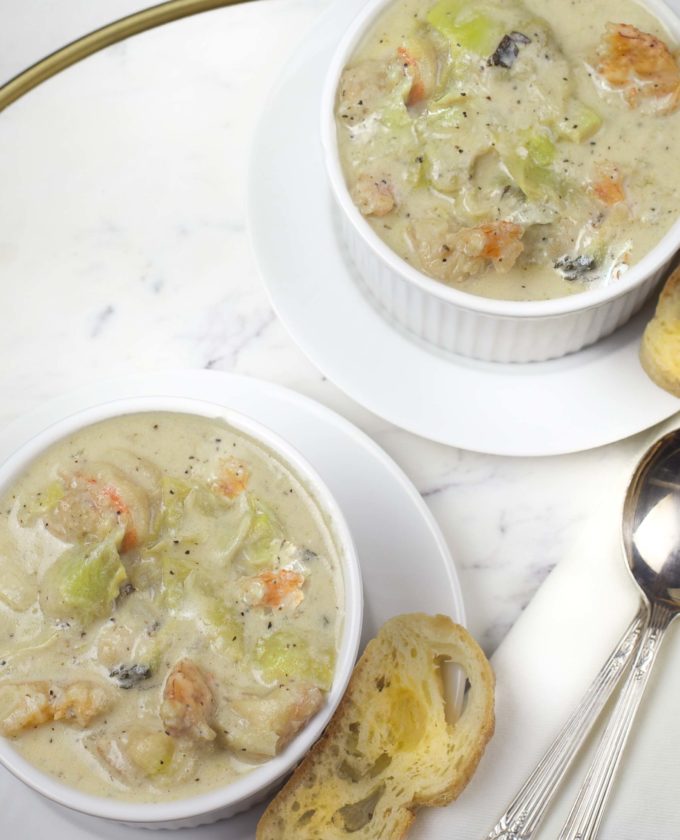
An elegant starter or a complete entree, this Seafood Bisque is a hearty dish.
YOUR SEAT AT THE TABLE: If you like this Cajun cooking story and Cajun recipe then accept my personal invitation to subscribe by entering your email at the bottom or top right of this page. It’s quick and painless. You will receive an email alert and be the first to see when new Cajun cooking stories and Cajun recipes are added. Thanks, George.
The post Seafood Bisque appeared first on Acadiana Table.
- Peggy’s Skillet Fried Chicken
Peggy is my momma. She passed away some time ago, but not before I learned her secret to the perfect fried chicken that I affectionately call Peggy’s Skillet Fried Chicken. She was a wiz in the kitchen and taught me the basics of cooking simply. She was a patient cook and knew that time was the most important elemental technique of cooking. Rush a recipe and you are sure to come up short.
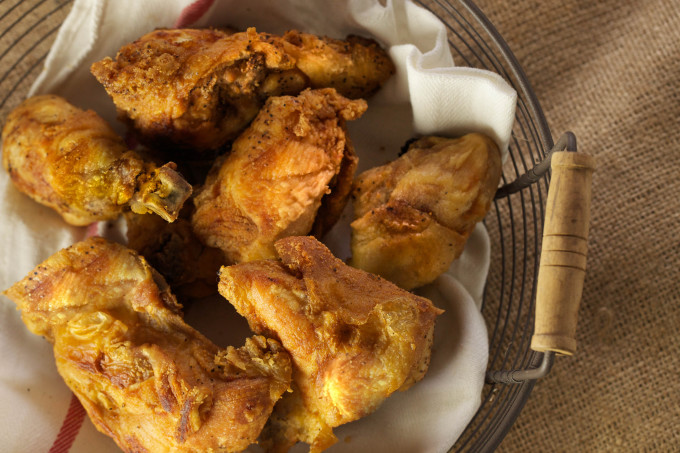
Moist and juicy on the inside and golden brown crispy on the outside. This is Peggy’s Skillet Fried Chicken – my momma’s Cajun recipe for the perfect Louisiana fried chicken. (All photos credit: George Graham)
Frying chicken is a Southern art form and family recipes are protected and passed down through generations. Techniques, ingredients, and methods vary, but the end result is most always consistently good. Fried chicken is best cooked in the home kitchen, and while there are good restaurant fried chicken variations out there, I have never tasted one that came close to my momma’s. Fried chicken–more than any other dish of the Deep South–is an emotional tie to memories of childhood and family. Most every family has a treasured recipe.
On what would have been her 107th birthday, here’s Peggy’s Skillet Fried Chicken.
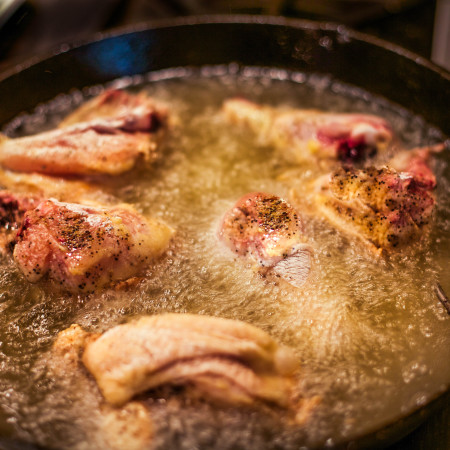
A cast-iron skillet is the secret to this Cajun recipe for Peggy’s Skillet Fried Chicken.
Those in the know, my momma for sure, understand that properly fried chicken can only be obtained through the heat-conducting magic of cast iron. Keeping an even high temperature throughout the cooking process insures that the chicken cooks evenly to a perfect crisp. Listen carefully: If the temperature falls, you are sure to fail. That said, always use a thermometer and start out with extra hot oil with a temperature reading of 400ºF. Once your chicken hits the pan, the hot oil will cool, and you will quickly reach your ideal frying temp of 375ºF.
Now that we have that out of the way, let’s talk ingredients and method. Take your time and brine is a cardinal rule of chicken cooking in the Graham kitchen. A good soaking in spiced up buttermilk with a healthy dash of Tabasco adds flavor to the chicken and gives the flour something to stick to. White Lily brand all-purpose flour is the go-to coating for most Southern cooks, and my family’s Cajun recipe for Peggy’s Skillet Fried Chicken is no different. In South Louisiana, we like to season our flour with a good dose of Cajun seasoning mix along with an extra punch of paprika and black pepper. And that’s that.
With Peggy’s Skillet Fried Chicken recipe, it’s really all very simple, but it is an adherence to those few traditional rules that is the difference between making chicken and making memories.
Happy heavenly birthday, Momma!
Peggy's Skillet Fried ChickenPrep timeCook timeTotal timeThis is my momma's basic fried chicken recipe and I suggest serving it the old fashioned way with mashed potatoes and white gravy.Recipe by: George Graham - AcadianaTable.comServes: 4Ingredients- 1 whole 4-pound chicken, cut into individual pieces
- 1 quart buttermilk
- 2 tablespoons salt
- 2 tablespoons black pepper
- 2 tablespoons garlic powder
- 2 tablespoons onion powder
- 2 tablespoons smoked paprika
- 8 tablespoons Acadiana Table Cajun Seasoning Blend, see recipe here
- 2 tablespoons hot sauce
- 1 gallon peanut oil
- 3 cups all-purpose flour
- 4 tablespoons smoked paprika
- 2 tablespoons black pepper
- Kosher salt
Instructions- In a large covered container, add the chicken pieces and cover with the buttermilk. Add the salt, pepper, garlic powder, onion powder, paprika, 4 tablespoons Cajun seasoning, and hot sauce. Stir to combine the ingredients and cover. Refrigerate for at least 3 hours or preferably overnight.
- Two hours before cooking, remove the chicken from the brine and place on a wire rack to drain and come to room temperature.
- In a large cast-iron skillet (or pot) over medium-high heat, pour enough oil to a 3-inch depth of the pan (no more than halfway up the side). With a cooking thermometer in place, heat the oil to 400ºF.
- In a shallow pan, add the flour, remaining 4 tablespoons Cajun seasoning, paprika, and pepper and mix together to combine. Add several of the chicken pieces to the flour mixture and coat. Add the chicken to the hot oil being careful not to crowd the pan. As the temperature of the oil drops adjust the heat to maintain a consistent 375ºF level.
- Let the chicken cook uncovered until it begins to brown on one side and then turn. Cook the other side until golden brown and crispy, about 15 minutes total. Check for doneness by inserting a meat thermometer into the thickest piece and look for an internal temperature of 160ºF. Remove the chicken and let drain on a wire rack. Sprinkle with kosher salt. Keep warm until all the chicken is fried.
NotesTimes do not include marinade time. For even frying, cut the larger chicken breasts in half to about the same size as the other pieces. I like peanut oil for frying chicken, but canola, vegetable or even lard will work. Fry enough of this chicken recipe to not only feed your hungry guests, but enough for a late night snack for yourself. You deserve it.3.5.3217
YOUR SEAT AT THE TABLE: If you like this Cajun cooking story and Cajun recipe then accept my personal invitation to subscribe by entering your email at the bottom or top right of this page. It’s quick and painless. You will receive an email alert and be the first to see when new Cajun cooking stories and Cajun recipes are added.
Thanks, George.The post Peggy’s Skillet Fried Chicken appeared first on Acadiana Table.
Website/Blog

